hankyoreh
Links to other country sites 다른 나라 사이트 링크
[Seoul travels] Naengmyeon in Mugyo and Seoul’s true identity
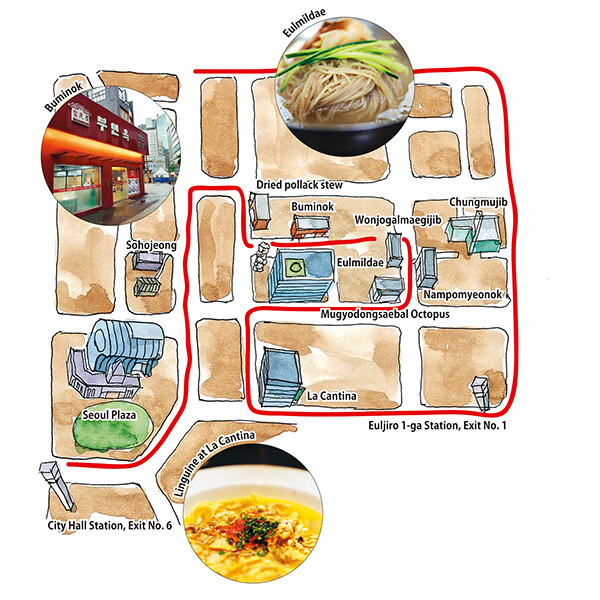
“How about we get some noodles? We haven’t done that in a while,” joked a friend of mine, using a silly misreading of a Chinese character.
I was delighted by my friend’s lunch suggestion. The two of us consider ourselves connoisseurs of noodle cuisine. We enjoy dining on noodle dishes of all kinds, including jjajangmyeon, guksu, pasta, pho, udon, ramen, and kalguksu. But on that hot summer day, we decided to have some naengmyeon, a cold noodle dish, near City Hall Station.
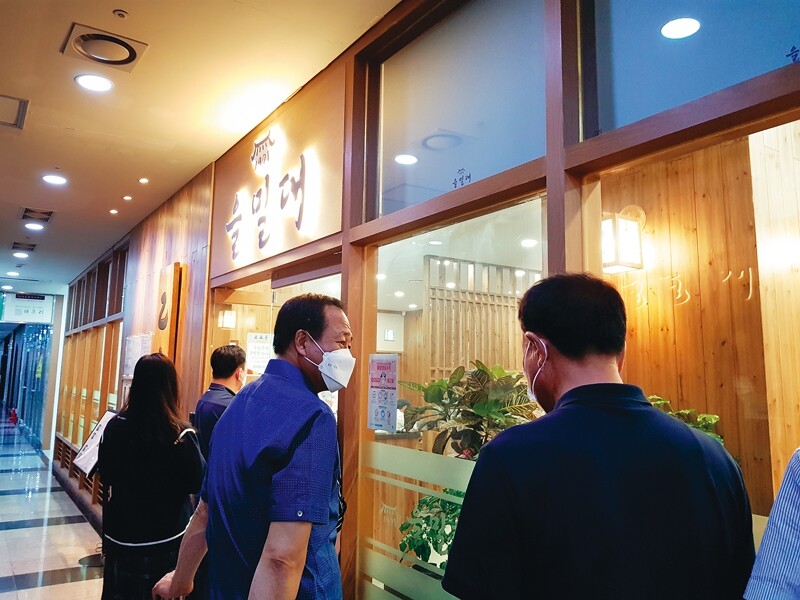
The fountains of Seoul Plaza were shooting up refreshing bursts of water into the shimmering heat. Beyond the vast lawn, the sturdy gates of the Seoul Metropolitan Library were open once more. Just as the library in the old city hall building represents the intellectual façade of Seoul, the Mugyo neighborhood expresses another side of the city.
“It’s been so long since we’ve met up at a naengmyeon restaurant that I’m really quite embarrassed,” my friend said, using another pun on noodles.
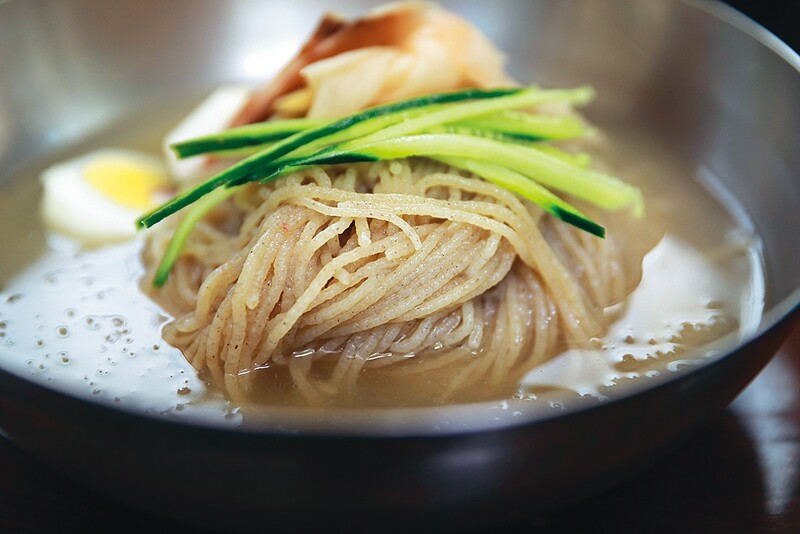
It’s typical for our meet ups to kick off with some wordplay.
The greeting was a complicated mix of phrases using the syllable “myeon” -- which in Korean can variously mean the pages of a newspaper, “face” (pride), or noodles. For people who work with the spoken and written word, language is both part of the job and a sort of hobby. It is, after all, the cheapest way of releasing stress. Their tastes ordinarily run to Eulji Noodle Restaurant, but we met at Eulmildae, which had just opened a new branch in Mugyo. The reason was simple: they had a busy schedule that morning, and it was close to work. In addition to those two naengmyeon restaurants, they have a predilection for certain others that goes beyond simple “liking” to reach the realm of fanatical devotion -- including Pyongyang Myeonok, Pildong Myeonok, Woolaeok, and Ojang-dong Hamhung Naengmyeon. Some people even exhibit a needless level of hostility toward other naengmyeon restaurants outside this core. Fortunately, these people did not fall into that category. I might be termed a “student of noodles,” as I enjoy touring the different traditional naengmyeon restaurants in Seoul based on the style my fellow diners prefer.
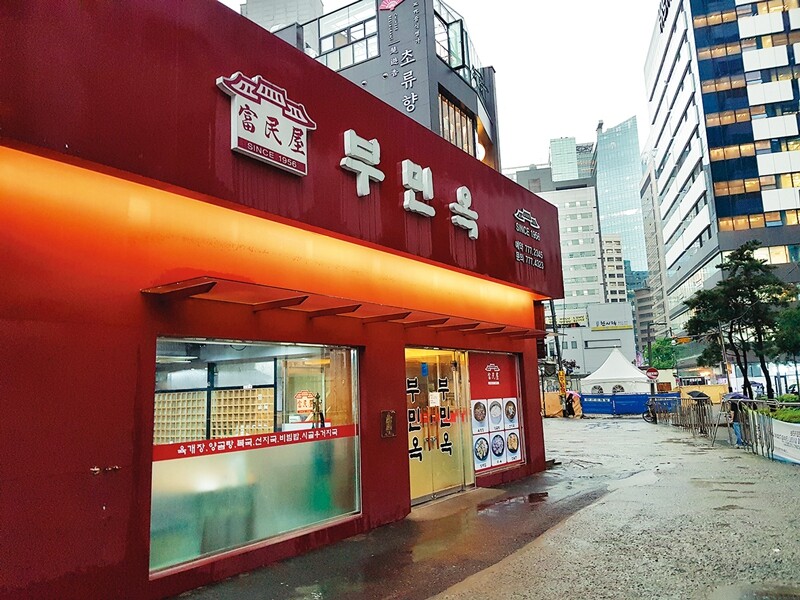
Around the tables, the neighborhood is unquestionably Mugyo. It’s lunchtime, and people everywhere are dining in the same way: starting with a plate of mung bean pancakes or boiled meat slices in the middle and polishing off some soju or makgeolli before proceeding to their cold noodles. Just as wine is a standard part of lunches in France and Italy, and it is not unusual for Germans to order beer instead of water, so Mugyo has its own dining culture: the tradition known as “seonju humyeon,” literally meaning “drinks first, noodles later.” They say it’s the “Mugyo way” to have some alcoholic beverages on the side -- even during lunchtime at restaurants like Yonggeumok (said to be one of Seoul’s three best restaurants for loach soup), Buminok (with its copious drinking snacks), Nampo Myeonok (favored by politicians), and Chungmujip (famous for its croaker stew and sea squirt rice).
A special place in the old cityMugyo holds a special meaning for the people who’ve long worked in Seoul’s older city. The number of soju glasses tilted there signifies the length of one’s career history. During the era when working nights was a daily occurrence and weekends were nonexistent, colleagues would console each other over beer and snails; the following morning, they’d bond over a bowl of dried pollack or bean sprout hangover stew. Every side street of Muryo bears the stamp of its workers’ joys, sorrows, and pathos.
But with the rapid changes in the times, Mugyo’s “seonju humyeon” culture is gradually vanishing into legend. Whereas it was seen as normal in the past to order a bottle of soju or makgeolli over lunch, people who do so today are seen as strange, even antisocial.
“I’m just so happy we can meet again, share a glass of soju, and enjoy a nice chat before heading back so we can enjoy the rest of our workday.”

The parting words of my fellow diner felt somehow plaintive. Just as the faces of the people passing by on the alleys looked different, so Mugyo was no longer the neighborhood I knew. One difference was the large number of restaurants that would not take orders after 9 pm. After taking a walk around the old stores along the side streets, I exited along the road by City Hall and headed toward the Eulji Road entrance. The Samsung Building next to the former US Culture Center had a sign reading “La Cantina.” Opened in 1967, it’s the oldest Italian restaurant still operating in Seoul. The name refers in Italian to a wine cellar, but it also means a place where you can enjoy wine with your meal. You can order from a wide variety of pastas to suit your taste -- spaghetti, linguine, tagliatelle, fettuccine, penne, rigatoni, gnocchi, and more -- and the restaurant’s name is a famous one among those who fancy themselves connoisseurs of Western-style noodles.
“Do the waiters there still bring you food in black suits? I went there quite a few times at its peak.”
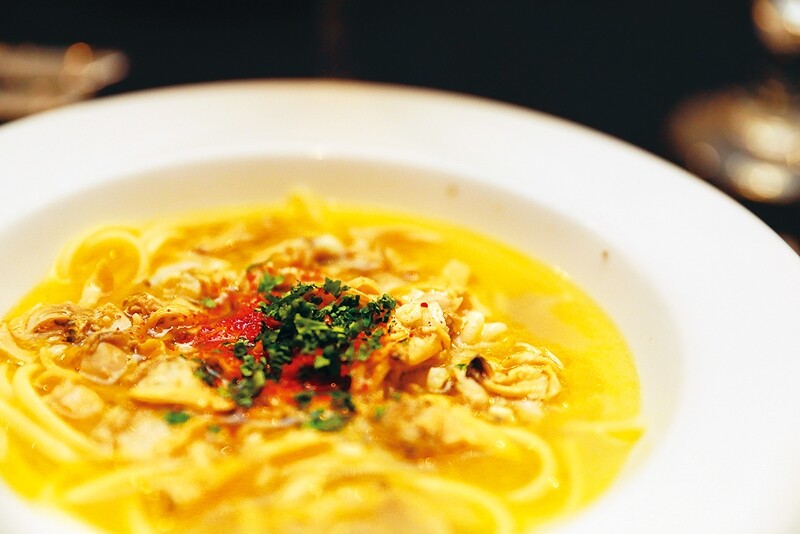
Alongside Hadongkwan, La Cantina is one of the few traditional restaurants where I share an experience in common with my father-in-law, who turns 94 this year. In an era when fusion is the big trend, La Cantina’s middle-aged waiters still take your order dressed in suits, and silver platters rest on the tables here. In the days when foreign travel was something relatively new, higher-ranking staff at places like the Samsung Group came here before their business trips to practice table manners and learn about Western dishes -- making it a kind of “officer training school” for Western cuisine. People who visit decades-old restaurants in Seoul often complain that while the food is delicious, the people are unfriendly or the toilets are unhygienic. La Cantina has been around for over 50 years, but remains clean and elegant.
Whenever I had a lunch date here after a night of heavy drinking, I would make sure to order the “Linguine La Cantina.” It was like a pasta version of kalguksu, with linguine boiled in a clam broth -- and I have yet to find a better dish for relieving a hangover.
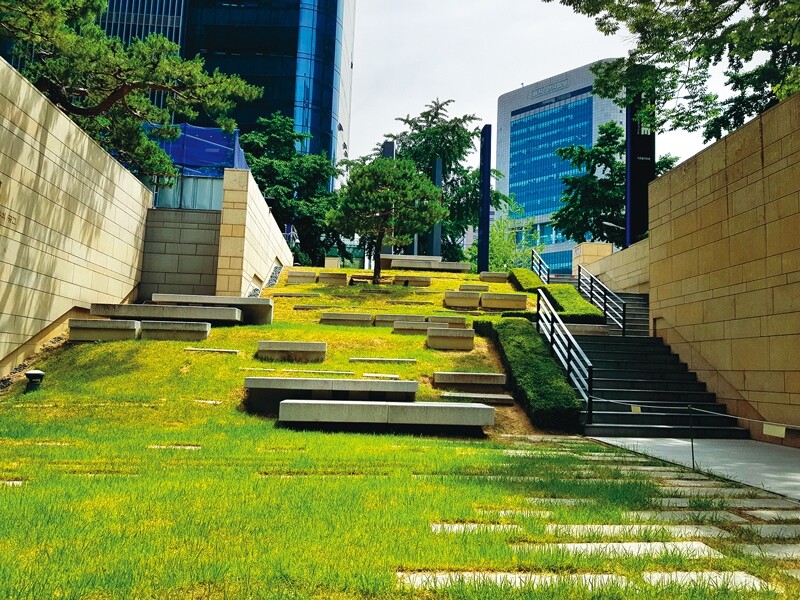
The name “Mugyo” typically refers to both Mugyo proper and Da-dong, the two neighborhoods located between Seoul City Hall and Cheonggye Stream. During the Joseon era, there was a bridge known as “Mojeon Bridge,” so named for the fruit shops (mojeon) in the Cheonggye Stream area. There was also another Mojeon Bridge (Lower Mojeon Bridge) at the site of a government office making weapons where City Hall stands today. To distinguish it from “Upper Mojeon Bridge,” the character “mu” -- meaning “weapon” -- was added to “gyo” (bridge) to give the name “Mugyo.” Mugyo is like an island, in between Cheonggye Stream flowing on one side and the most bustling of business districts on the other.
Mugyo is a place that has Western pasta restaurants boasting long traditions on its main roads, and longstanding Korean noodle restaurants continuing undaunted on the alleys behind them. One delight of Seoul is venturing through its mazes of narrow side streets and alleyways, like embarking on a game in the heart of the city. Tradition isn’t just about hanbok clothes, gugak instruments, and tile roofs. It’s something that needs to exist beside us like a living thing. I see tradition as truly being alive when sons visit the same noodle restaurants their fathers frequented, and young women dine at the same naengmyeon restaurants their grandmothers loved. It is when historic things like this live on that the city truly stands proud. That is its true identity.
By Son Kwan-seung, travel writer
Edited by Seoul& editorial board
Please direct comments or questions to [english@hani.co.kr]
Editorial・opinion
![[Column] Season 2 of special prosecutor probe may be coming to Korea soon [Column] Season 2 of special prosecutor probe may be coming to Korea soon](https://flexible.img.hani.co.kr/flexible/normal/500/300/imgdb/original/2024/0426/3317141030699447.jpg) [Column] Season 2 of special prosecutor probe may be coming to Korea soon
[Column] Season 2 of special prosecutor probe may be coming to Korea soon![[Column] Park Geun-hye déjà vu in Yoon Suk-yeol [Column] Park Geun-hye déjà vu in Yoon Suk-yeol](https://flexible.img.hani.co.kr/flexible/normal/500/300/imgdb/original/2024/0424/651713945113788.jpg) [Column] Park Geun-hye déjà vu in Yoon Suk-yeol
[Column] Park Geun-hye déjà vu in Yoon Suk-yeol- [Editorial] New weight of N. Korea’s nuclear threats makes dialogue all the more urgent
- [Guest essay] The real reason Korea’s new right wants to dub Rhee a founding father
- [Column] ‘Choson’: Is it time we start referring to N. Korea in its own terms?
- [Editorial] Japan’s rewriting of history with Korea has gone too far
- [Column] The president’s questionable capacity for dialogue
- [Column] Are chaebol firms just pizza pies for families to divvy up as they please?
- [Column] Has Korea, too, crossed the Rubicon on China?
- [Correspondent’s column] In Japan’s alliance with US, echoes of its past alliances with UK
Most viewed articles
- 1AI is catching up with humans at a ‘shocking’ rate
- 2‘We must say no’: Seoul defense chief on Korean, USFK involvement in hypothetical Taiwan crisis
- 3[Column] Season 2 of special prosecutor probe may be coming to Korea soon
- 4Is Japan about to snatch control of Line messenger from Korea’s Naver?
- 5Korea sees more deaths than births for 52nd consecutive month in February
- 6Amnesty notes ‘erosion’ of freedom of expression in Korea in annual human rights report
- 7[Editorial] Korea’s surprise Q1 growth requires objective assessment, not blind fanfare
- 8Is N. Korea threatening to test nukes in response to possible new US-led sanctions body?
- 9Foreign workers live behind daunting language barrier
- 10Park administration’s distorted history textbooks made public